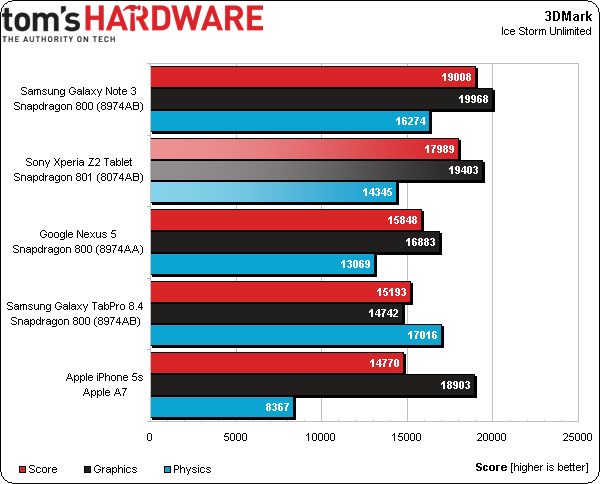Qualcomm Snapdragon 801: Performance Previewed
Snapdragon 801, the recently-announced update to the Snapdragon 800, shares some of the same SKUs as Snapdragon 800. So, how do you tell the difference? We break down the family and introduce you to the first benchmarks of Sony's Xperia Z2 tablet, too.
3DMark And Basemark X 1.1
3DMark: Ice Storm Unlimited
Ice Storm simulates the demands of OpenGL ES 2.0-based games using shaders, particles, and physics via the company’s in-house engine. While it was just released in May of last year, the on-screen portions of Ice Storm have already been outpaced by more recent mobile chipsets, with Nvidia’s Tegra 4 and Qualcomm’s Snapdragon 800 both easily maxing out the Extreme version (1080p with high-quality textures). However, Ice Storm Unlimited, which renders the scene off-screen at 720p is still a good gauge of GPU-to-GPU performance.
The Sony Xperia Z2 Tablet jumps up the ladder, taking second place with ease. Its improved Snapdragon 801 Adreno 330 GPU core (578 MHz versus the standard 450 MHz of Snapdragon 800) gives it a 15% lead over the Nexus 5 in the Graphics sub-test, and a 31% lead over Samsung's Galaxy Tab Pro 8.4. Assuming the memory bandwidth issue affects 3D workloads as well, those numbers could go up as Sony finalizes its hardware configuration.
Basemark X 1.1
Basemark X is a multi-platform suite based on a real game engine, Unity 4.0. It uses many of Unity’s modern features via the OpenGL ES 2.0 render path, just as a modern title might. Features like high poly-count models, shaders with normal maps, complex LoD algorithms, extensive per-pixel lighting (including directional and point light), along with a comprehensive set of post process, particle systems, and physics effects test how a modern game would look and run. It’s an aggressive test that still hasn’t been maxed out by the latest SoCs.
The Sony Xperia Z2 tablet takes third place in the medium quality metric, which doesn't surprise us, given the memory bandwidth results measured previously. Any workload limited by throughput is going to suffer, regardless of GPU clock rate increases.
Shifting to high quality apparently alleviates that bottleneck somewhat, resulting in a second-place finish behind Apple's A7. Fortunately, the next page of benchmarks should allow us to isolate the GPU more pointedly, without as much interference from other subsystems.
Get Tom's Hardware's best news and in-depth reviews, straight to your inbox.
Current page: 3DMark And Basemark X 1.1
Prev Page AnTuTu 4, Basemark OS II, And Geekbench 3 Next Page GFXBench 3.0: Manhattan And T-Rex-
Wisecracker A Temash APU and Atom SoCs would make a great cross-platform comparison, here.Reply
The 'Droid Heads would love to see some Tegra 3/4 action, too. -
MANOFKRYPTONAK I really am looking forward to the showdown between the A7/A8, Tegra4/K1. and Intel "what is the name of the chip in the nexus 8?". I hoping to see a worthy $500 upgrade.Reply -
anthony8989 Great article - very informative. Sorry if it's off-topic, but the HTC One (M7 2013) uses an APQ8064T. Did Qualcomm change the meaning of the second numeral from Snapdragon 600 to 80x? The HTC One M7 employs a modem yet now the second numeral being 0 indicates no modem. Or does the device substitute another modem off the SoC? Also what does the "T" suffix mean? :)Reply
EDIT: I realized APQ also indicates no modem so I'll just assume that they supplied an off-SoC modem for the device. Still would like to know what "T"stands for. -
rohitbaran Isn't Tegra K1 (aka Logan) having something else? Project Denver CPU was supposed to be part of Parker SoC as per nVidia's 2013 Tegra roadmap, unless I am missing something.Reply -
edlivian So if you already have a device with a snapdragon 800 you should hold off for a real improvement, like snapdragon 1000 or 1k or whatever marketing jibberish they want to name it.Reply -
edlivian So if you already have a device with a snapdragon 800 you should hold off for a real improvement, like snapdragon 1000 or 1k or whatever marketing jibberish they want to name it.Reply -
Vistouf From Wikipedia :"SKU refers to a stock-keeping unit, a unique identifier for each distinct product and service that can be purchased in business."Reply -
PapaCrazy They compared two different manufacturers devices from two generations in order to extrapolate something about the chip? Huh? What about differences in hardware implementation, software, memory, and all the other things that can independently effect performance? Would have been much better to wait and have more comparable devices to test.Reply

